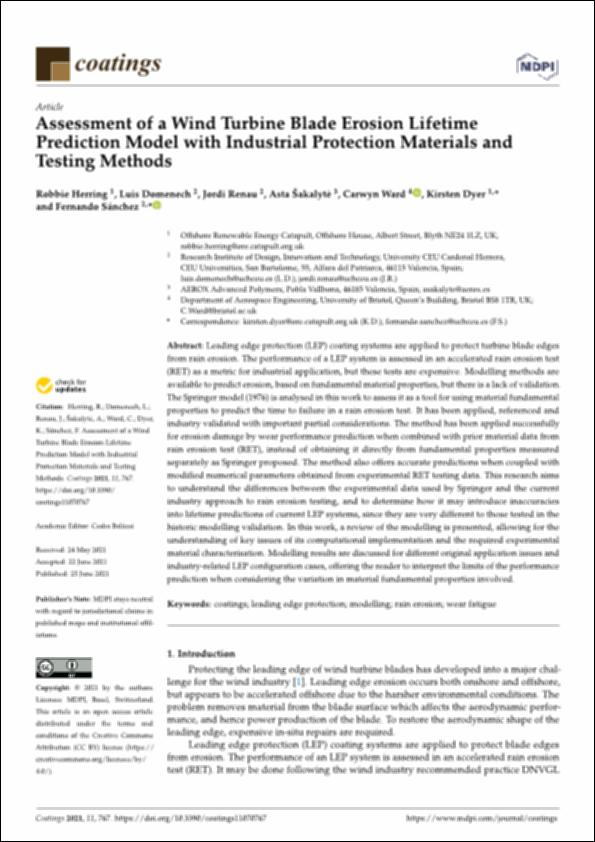Por favor, use este identificador para citar o enlazar este ítem:
http://hdl.handle.net/10637/13645Assessment of a wind turbine blade erosion lifetime prediction model with industrial protection materials and testing methods
| Título : | Assessment of a wind turbine blade erosion lifetime prediction model with industrial protection materials and testing methods |
| Autor : | Herring, Robbie Doménech Ballester, Luis Renau Martínez, Jordi Sakalyté, Asta Ward, Carwyn Dyer, Kirsten Sánchez López, Fernando |
| Materias: | Materiales - Fatiga.; Erosión pluvial.; Protective coatings.; Rain erosion.; Materiales de revestimiento.; Coatings.; Revestimientos protectores.; Materials - Fatigue. |
| Editorial : | MDPI |
| Citación : | Herring, R., Domenech, L., Renau, J., Šakalytė, A., Ward, C., Dyer, K. & Sánchez, F. (2021). Assessment of a wind turbine blade erosion lifetime prediction model with industrial protection materials and testing methods. Coatings, vol. 11, i. 7 (25 jun.), art. 767. DOI: http://dx.doi.org/10.3390/coatings11070767 |
| Resumen : | Leading edge protection (LEP) coating systems are applied to protect turbine blade edges from rain erosion. The performance of a LEP system is assessed in an accelerated rain erosion test (RET) as a metric for industrial application, but these tests are expensive. Modelling methods are available to predict erosion, based on fundamental material properties, but there is a lack of validation. The Springer model (1976) is analysed in this work to assess it as a tool for using material fundamental properties to predict the time to failure in a rain erosion test. It has been applied, referenced and industry validated with important partial considerations. The method has been applied successfully for erosion damage by wear performance prediction when combined with prior material data from rain erosion test (RET), instead of obtaining it directly from fundamental properties measured separately as Springer proposed. The method also offers accurate predictions when coupled with modified numerical parameters obtained from experimental RET testing data. This research aims to understand the differences between the experimental data used by Springer and the current industry approach to rain erosion testing, and to determine how it may introduce inaccuracies into lifetime predictions of current LEP systems, since they are very different to those tested in the historic modelling validation. In this work, a review of the modelling is presented, allowing for the understanding of key issues of its computational implementation and the required experimental material characterisation. Modelling results are discussed for different original application issues and industry-related LEP configuration cases, offering the reader to interpret the limits of the performance prediction when considering the variation in material fundamental properties involved. |
| Descripción : | Este artículo se encuentra disponible en la siguiente URL: https://www.mdpi.com/2079-6412/11/7/767 Este artículo pertenece al número especial "Wind Turbine Blade Coatings: New Advances, Application and Challenges". |
| URI : | http://hdl.handle.net/10637/13645 |
| Derechos: | http://creativecommons.org/licenses/by/4.0/deed.es |
| ISSN : | 2079-6412 (Electrónico) |
| Fecha de publicación : | 25-jun-2021 |
| Centro : | Universidad Cardenal Herrera-CEU |
| Aparece en las colecciones: | Dpto. Matemáticas, Física y Ciencias Tecnológicas |
Los ítems de DSpace están protegidos por copyright, con todos los derechos reservados, a menos que se indique lo contrario.


